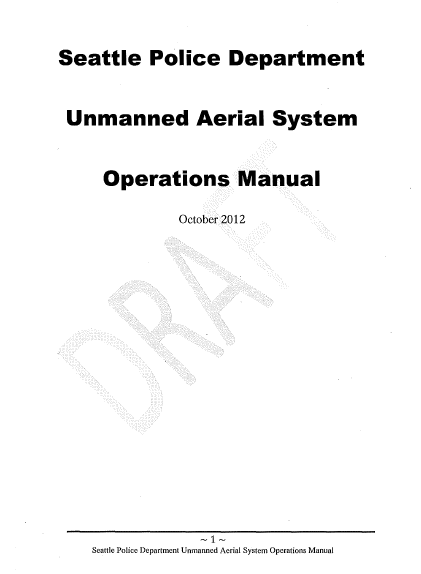The following is the draft unmanned aerial system manual released last month by the Seattle Police Department. Thanks to Carlton Purvis for pointing it out to us.
Seattle Police Department Unmanned Aerial System Operations Manual
- Draft
- 14 pages
- October 2012
The following procedures are intended to promote safe, efficient and lawful operation of the Seattle Police Department’s unmanned aerial system (UAS). Safety, above all else, is the primary concern in each and every operation, regardless of the nature of the mission.
2. Philosophy & Mission Statement
It shall be the mission of those personnel of the Seattle Police Department who are trained in the use of unmanned aerial systems (UAS), to use this resource to protect the lives and property of citizens and first responders in a constitutionally and legally sound manner. Use of an aerial system can be utilized in circumstances which would save life and property, as well as being able to detect possible dangers that could not otherwise be seen.
The use of UAS’s is quickly growing but had it been available during large catastrophes such as hurricane Katrina, it would have had a large impact on all aspects of emergency response when personnel were in short supply.
UAS’s can support any responder in any all-hazards incident that would benefit from an aerial perspective, Additionally, the UAS would have suitable uses in locating and apprehending subjects, missing persons, search and rescue operations as well as any task that can best be accomplished from the air in an efficient and effective manner.
It shall be the intent of every UAS operator to make reasonable effort to not invade a person’s reasonable expectation of privacy when operating the UAS. When operating the UAS, the Seattle Police Department will abide by all FAA Regulations for flight and receive the proper authorization for flight. Additionally, the need, availability and use of the UAS will not supersede the issuance of a warrant when needed.
3. Protection of Rights and Privacy
UAS unit Commanders, operators and observers will have the protection of citizens civil rights and reasonable expectations of privacy as a key component of any decision made the to deploy the UAS. UAS operators and observers will ensure and will be held accountable for ensuring that operations of the U AS intrude to a minimal extent upon the citizens of Seattle. To accomplish this primary goal we will:
a) When the UAS is being flown the onboard cameras will be turned so as to be facing away from occupied structures, etc to minimize inadvertent video or still images of uninvolved persons.
b) All video and still images will be maintained in strict compliance with SPD policies and procedures.
c) A website for public input will be maintained and regularly monitored to address citizen concerns and recommendations
d) The SPD UAS unit will not conduct random surveillance activities. The use of the UAS will be tightly controlled and regulated.
e) The authorized missions for the SPD UAS are:
a. Video/photographs for investigative support (TCI, Homicide, ABS)
b. HAZMAT Response
c. Search and Rescue
d. Barricaded persons
e. Traffic collisions
f. Disaster Response (Flood, earthquakes, etc.)All other requested uses will be approved by the Special Operations Bureau Chief prior to accepting the mission.
f) A committee will be formed and meet semi-annually for the purpose of reviewing the existing UAS procedures as well as new technologies and laws and regulations on UAS usage. The committee will consist of personnel from SPD UAS, professional standards section and patrol representatives. The committee will present all proposed policy and procedures changes to the City Council, legal and community groups, and will solicit feedback prior to changing any policy changes,
g) The SPD UAS program will operate,strictly within the law and regulations. If in doubt, prior to operating the UAS we will ensure that warrants are applied for and obtained. We will balance all operations with. the need to accomplish the mission while maintaining public privacy and the freedom from intrusion.

